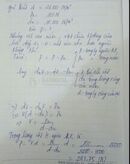Hãy nhập câu hỏi của bạn vào đây, nếu là tài khoản VIP, bạn sẽ được ưu tiên trả lời.

Câu 1 :
a) ĐKXĐ : \(\hept{\begin{cases}x+1\ne0\\2x-6\ne0\end{cases}}\) \(\Leftrightarrow\hept{\begin{cases}x\ne-1\\x\ne3\end{cases}}\)
b) Để \(P=1\Leftrightarrow\frac{4x^2+4x}{\left(x+1\right)\left(2x-6\right)}=1\)
\(\Leftrightarrow\frac{4x^2+4x-\left(x+1\right)\left(2x-6\right)}{\left(x+1\right)\left(2x-6\right)}=0\)
\(\Rightarrow4x^2+4x-2x^2+4x+6=0\)
\(\Leftrightarrow2x^2+8x+6=0\)
\(\Leftrightarrow x^2+4x+4-1=0\)
\(\Leftrightarrow\left(x+2-1\right)\left(x+2+1\right)=0\)
\(\Leftrightarrow\orbr{\begin{cases}x+1=0\\x+3=0\end{cases}}\) \(\Leftrightarrow\orbr{\begin{cases}x=-1\left(KTMĐKXĐ\right)\\x=-3\left(TMĐKXĐ\right)\end{cases}}\)
Vậy : \(x=-3\) thì P = 1.

a) ĐK : \(x\ne1\); \(x\ne-1\)
b) Ta có biểu thức:
\(B=\left(\frac{x+1}{2x-2}+\frac{3}{x^2-1}-\frac{x+3}{2x+2}\right).\left(\frac{4x^2-4}{5}\right)\)
\(=\left(\frac{x+1}{2.\left(x-1\right)}+\frac{3}{\left(x+1\right)\left(x-1\right)}-\frac{x+3}{2.\left(x+1\right)}\right).\left(\frac{4.\left(x^2-1\right)}{5}\right)\)
\(=\frac{\left(x+1\right)^2+3.2-\left(x+3\right)\left(x-1\right)}{2.\left(x-1\right)\left(x+1\right)}.\frac{4.\left(x+1\right)\left(x-1\right)}{5}\)
\(=\frac{x^2+2x+2+6-x^2-2x+3}{2.\left(x-1\right)\left(x+1\right)}.\frac{4.\left(x+1\right)\left(x-1\right)}{5}=\frac{40.\left(x+1\right)\left(x-1\right)}{10.\left(x+1\right)\left(x-1\right)}=4\)
Vậy giá trị của biểu thức B không phụ thuộc vào biến x khi \(x\ne1;x\ne-1\)

a) ĐKXĐ: \(\hept{\begin{cases}2x-2\ne0\\x^2-1\ne0\\2x+2\ne0\end{cases}}\)\(\Leftrightarrow\hept{\begin{cases}x\ne1\\x\ne-1\end{cases}}\)
b) bạn rút gọn, biểu thức sẽ bằng 4
=> giá tri của biểu thức sẽ không phụ thuộc vào biến x
tôi vướng ở câu b giải cứ bị lẫn giải ra vẫn có biến x giải họ tôi cái

a, ĐK: \(\hept{\begin{cases}x+2\ne0\\x\ne0\end{cases}\Rightarrow}\hept{\begin{cases}x\ne-2\\x\ne0\end{cases}}\)
b, \(B=\left(1-\frac{x^2}{x+2}\right).\frac{x^2+4x+4}{x}-\frac{x^2+6x+4}{x}\)
\(=\frac{-x^2+x+2}{x+2}.\frac{\left(x+2\right)^2}{x}-\frac{x^2+6x+4}{x}\)
\(=\frac{\left(-x^2+x+2\right)\left(x+2\right)-\left(x^2+6x+4\right)}{x}\)
\(=\frac{-x^3-2x^2+x^2+2x+2x+4-\left(x^2+6x+4\right)}{x}\)
\(=\frac{-x^3-2x^2-2x}{x}=-x^2-2x-2\)
c, x = -3 thỏa mãn ĐKXĐ của B nên với x = -3 thì
\(B=-\left(-3\right)^2-2.\left(-3\right)-2=-9+6-2=-5\)
d, \(B=-x^2-2x-2=-\left(x^2+2x+1\right)-1=-\left(x+1\right)^2-1\le-1\forall x\)
Dấu "=" xảy ra khi \(x+1=0\Rightarrow x=-1\)
Vậy GTLN của B là - 1 khi x = -1

a) ĐKXĐ: \(\hept{\begin{cases}x+2\ne0\\x^2-4\ne0\\2-x\ne0\end{cases}}\) => \(\hept{\begin{cases}x\ne-2\\x\ne\pm2\\x\ne2\end{cases}}\) => \(x\ne\pm2\)
Ta có:Q = \(\frac{x-1}{x+2}+\frac{4x+4}{x^2-4}+\frac{3}{2-x}\)
Q = \(\frac{\left(x-1\right)\left(x-2\right)}{\left(x+2\right)\left(x-2\right)}+\frac{4x+4}{\left(x-2\right)\left(x+2\right)}-\frac{3\left(x+2\right)}{\left(x-2\right)\left(x+2\right)}\)
Q = \(\frac{x^2-2x-x+2+4x+4-3x-6}{\left(x+2\right)\left(x-2\right)}\)
Q = \(\frac{x^2-2x}{\left(x+2\right)\left(x-2\right)}=\frac{x\left(x-2\right)}{\left(x+2\right)\left(x-2\right)}=\frac{x}{x+2}\)
b) ĐKXĐ P: x - 3 \(\ne\)0 => x \(\ne\)3
Ta có: P = 3 => \(\frac{x+2}{x-3}=3\)
=> x + 2 = 3(x - 3)
=> x + 2 = 3x - 9
=> x - 3x = -9 - 2
=> -2x = -11
=> x = 11/2 (tm)
Với x = 11/2 thay vào Q => Q = \(\frac{\frac{11}{2}}{\frac{11}{2}+2}=\frac{11}{15}\)
c) Với x \(\ne\)\(\pm\)2; x \(\ne\)3
Ta có: M = PQ = \(\frac{x+2}{x-3}\cdot\frac{x}{x+2}=\frac{x}{x-3}=\frac{x-3+3}{x-3}=1+\frac{3}{x-3}\)
Để M \(\in\)Z <=> 3 \(⋮\)x - 3
=> x - 3 \(\in\)Ư(3) = {1; -1; 3; -3}
Lập bảng:
| x - 3 | 1 | -1 | 3 | -3 |
| x | 4 | 2 (ktm) | 6 | 0 |
Vậy ...

Dài quá trôi hết đề khỏi màn hình: nhìn thấy câu nào giải cấu ấy
Bài 4:
\(A=\frac{\left(x-1\right)+\left(x+1\right)}{\left(x+1\right)\left(x-1\right)}-\frac{2}{\left(x+1\right)\left(x-1\right)}=\frac{2\left(x-1\right)}{\left(x-1\right)\left(x+1\right)}\)
a) DK x khác +-1
b) \(dk\left(a\right)\Rightarrow A=\frac{2}{\left(x+1\right)}\)
c) x+1 phải thuộc Ước của 2=> x=(-3,-2,0))
1. a) Biểu thức a có nghĩa \(\Leftrightarrow\hept{\begin{cases}x+2\ne0\\x^2-4\ne0\end{cases}}\)
\(\Leftrightarrow\hept{\begin{cases}x+2\ne0\\x-2\ne0\\x+2\ne0\end{cases}}\)
\(\Leftrightarrow\hept{\begin{cases}x\ne-2\\x\ne2\end{cases}}\)
Vậy vs \(x\ne2,x\ne-2\) thì bt a có nghĩa
b) \(A=\frac{x}{x+2}+\frac{4-2x}{\left(x-2\right)\left(x+2\right)}\)
\(=\frac{x\left(x-2\right)}{\left(x+2\right)\left(x-2\right)}+\frac{4-2x}{\left(x+2\right)\left(x-2\right)}\)
\(=\frac{x^2-2x+4-2x}{\left(x+2\right)\left(x-2\right)}\)
\(=\frac{x^2-4x+4}{\left(x+2\right)\left(x-2\right)}\)
\(=\frac{\left(x-2\right)^2}{\left(x+2\right)\left(x-2\right)}\)
\(=\frac{x-2}{x+2}\)
c) \(A=0\Leftrightarrow\frac{x-2}{x+2}=0\)
\(\Leftrightarrow x-2=\left(x+2\right).0\)
\(\Leftrightarrow x-2=0\)
\(\Leftrightarrow x=2\)(ko thỏa mãn điều kiện )
=> ko có gía trị nào của x để A=0

a, ĐKXĐ: \(x\ne-3\) và \(x\ne\pm1\)
b, \(P=\frac{x\left(x+3\right)-11+x^2-3x+9}{x^3+27}:\frac{x^2-1}{x+3}\)
\(P=\frac{2x^2-2}{x^3+27}.\frac{x+3}{x^2-1}\)
\(=\frac{2\left(x-1\right)\left(x+1\right)}{\left(x+3\right)\left(x^2-3x+9\right)}.\frac{x+3}{\left(x-1\right)\left(x+1\right)}\)
\(=\frac{2}{x^2-3x+9}\)
c, \(P=\frac{2}{x^2-3x+9}==\frac{2}{\left(x-\frac{3}{2}\right)^2+\frac{27}{4}}\le\frac{2}{\frac{27}{4}}=\frac{8}{27}\)
Dấu "=" xảy ra khi: \(x-\frac{3}{2}=0\Leftrightarrow x=\frac{3}{2}\)
Vậy P lớn nhất bằng \(\frac{8}{27}\) \(\Leftrightarrow x=\frac{3}{2}\)
\(P=\left(\frac{x}{x^2-3x+9}-\frac{11}{x^3+27}+\frac{1}{x+3}\right):\frac{x^2-1}{x+3}.\)
ĐKXĐ : \(x\ne-3;x\ne0\)
\(P=\left(\frac{x\left(x+3\right)}{\left(x+3\right)\left(x^2-3x+9\right)}-\frac{11}{\left(x+3\right)\left(x^2-3x+9\right)}+\frac{x^2-3x+9}{\left(x+3\right)\left(x^2-3x+9\right)}\right).\frac{x+3}{x^2-1}\)
\(P=\left(\frac{x^2+3x-11+x^2-3x+9}{\left(x+3\right)\left(x^2-3x+9\right)}\right).\frac{x+3}{x^2-1}\)
\(P=\frac{2x^2-2}{\left(x^2-3x+9\right)}.\frac{1}{x^2-1}=\frac{2\left(x^2-1\right)}{\left(x^2-3x+9\right)}.\frac{1}{x^2-1}\)
\(P=\frac{2}{x^2-3x+9}\)



